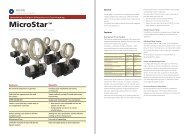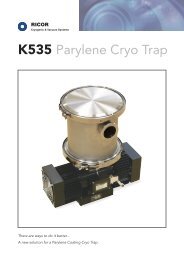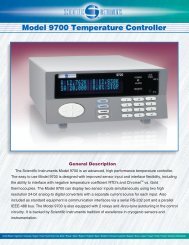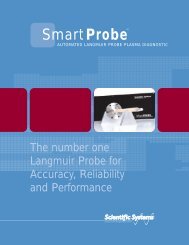You also want an ePaper? Increase the reach of your titles
YUMPU automatically turns print PDFs into web optimized ePapers that Google loves.
Easy to use: The Model 9302 & 9304 front panels consist of a<br />
large, bright Vacuum Fluorescent display and a 5-key keypad.<br />
Most features and functions can be accessed via this simple and<br />
intuitive menu drives interface. Two temperature readings can be<br />
displayed in a large, easy to read 10mm two-line font.<br />
Underlying menus switch to a 5mm high four-line font for more<br />
content. Additionally, the Model 9304 can display all four inputs<br />
plus alarm and relay status in this smaller font. Temperature<br />
displays are autoranged to show the most number of significant<br />
digits. Built-in digital filters can be used to smooth temperature<br />
data. Displays are in units of K, ˚C, ˚F, Volts, or Ohms. The<br />
status of built-in alarms and relays are indicated by LEDs<br />
located tot he right of the display.<br />
Outputs: The Model 9302 & 9304 each have two dry-contact<br />
relay outputs. Either may be independently programmed to<br />
assert or clear based on a high or low temperature condition.<br />
Normally-open contacts are available on the rear panel. Also<br />
available is a single analog output channel. This is a zero to 4<br />
Volt output that is proportional to any selected input.<br />
Data logging is performed by continuously recording<br />
temperature and status to an internal 20K byte circular memory<br />
buffer. Data is time stamped so that the actual time of an event<br />
can be determined. Non-volatile memory is used so that data<br />
will survive a power failure.<br />
Ethernet: The Model 9302 & 9304 connects directly to any 10-<br />
Based T Ethernet interface to make measurements easily and<br />
economically. Simple connection to any existing Local Area<br />
Network allows stable, precise, cost-effective measurements in<br />
laboratory or industrial environments as well as in remote,<br />
distributed data acquisition systems. The Model 9302 and 9304<br />
can even be connected directly to the Internet with a usersupplied<br />
IP address.<br />
Using Ethernet HTTP protocol, the monitor's embedded web<br />
server allows the instrument to be viewed and configured from<br />
any web browser.<br />
Rear Panel Connections<br />
Input Connectors: Two DB-9 receptacles<br />
provide 4-wire measurement connection to<br />
two sensors each.<br />
LAN: Standard RJ-45 Ethernet connector with<br />
built-in connection and activity LEDS.<br />
RS-232: Null-Modem connector (DB-9, pins).<br />
Relays / Analog Output: 6-pin detachable<br />
terminal block 3.5mm.<br />
AC Power: RFI filtered Power Entry Module<br />
including AC power line switch and fuse<br />
drawer. Line voltage selection is performed<br />
by Internal jumpers.<br />
Input channels can be configured using text entry and dropdown<br />
box selections by going to the monitor's "inputs" web page.<br />
Using SMTP protocol, the monitor will send e-mail based on<br />
selected alarm conditions. E-mail is completely configured by<br />
using the web page interface.<br />
The TCP/IP data port server brings fast Ethernet connectivity to<br />
all common data acquisition software programs including<br />
LabView TM .<br />
The TCP/IP protocol is used to implement a text based<br />
command language like those commonly used with IEEE-488 or<br />
RS-232 interfaces. This is the primary way that user software<br />
interfaces to the monitor.<br />
The remote command language is SCPI compliant according to<br />
the IEEE specification.<br />
With Ethernet connectivity, the user has complete control of the<br />
monitor by using any web-enabled device from desktop PC to a<br />
wireless Pocket PC TM . It is platform and operating system<br />
independent, working equally well with Windows, Linux or<br />
Macintosh based computers. There are no expensive cards or<br />
cables and, no confusing configuration requirements.<br />
Software: Utility software is provided that connects any<br />
Windows based personal computer to either monitor. This<br />
software provides a graphical control panel that greatly<br />
simplifies instrument setup and configuration.<br />
Sensor calibration curves may be downloaded to the monitor,<br />
viewed and edited.<br />
LabView: LabView TM drivers are provided for both the Ethernet<br />
TCP/IP and RS-232 interfaces.







